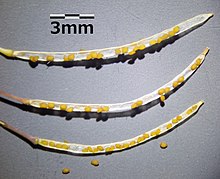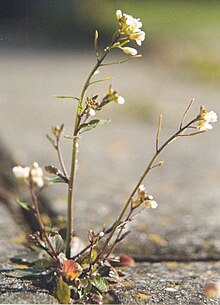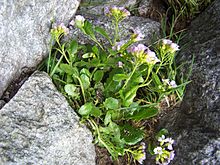Foam cress
| Foam cress | ||||||||||||
|---|---|---|---|---|---|---|---|---|---|---|---|---|

Sand-cress ( Arabidopsis arenosa ) |
||||||||||||
| Systematics | ||||||||||||
|
||||||||||||
| Scientific name | ||||||||||||
| Arabidopsis | ||||||||||||
| Heynh. ex Holl & Heynh. |
The foam cress ( Arabidopsis ) form a genus of plants in the cruciferous family (Brassicaceae). An important species in genetic research as a model organism is the thale cress ( Arabidopsis thaliana ).
description






Vegetative characteristics
The cress are annual, biennial or perennial, herbaceous plants . They form runners . The stems are mostly bare.
The shape of the sessile to short stalked leaves can vary widely. The basal rosette leaves have entire margins or lobes or pinnate to pinnate, while the stem leaves, on the other hand, usually have entire margins or are slightly toothed.
Generative characteristics
The flowers stand together in racemose inflorescences . The hermaphrodite flowers are fourfold. The four sepals are elongated. The four flower petals are arranged in the shape of a cross. The color of the petals is mostly white, often pink, rarely even purple. Of the six stamens , four are long in the middle and two shorter on the edge. The two carpels are a top permanent ovary grown.
The foam cress belong to the pod-fruited cruciferous vegetables. So your pods are three times as long as they are wide. The fruit flaps are paper-like. Each fruit contains many seeds.
Locations
Arabidopsis species thrive best on calcareous , nutrient-poor soils , some species also on rocks. Often they can also be found on railway grounds, on rubble sites or on gravel. They sometimes prefer relatively dry and light-rich locations.
Systematics and distribution
The genus Arabidopsis was established in 1842 by Gustav Heynhold in Friedrich Holl & Gustav Heynhold: Flora von Sachsen , Volume 1, p. 538.
The genus Arabidopsis was scientifically processed and redefined at the beginning of the 21st century. In the course of this revision , the formerly independent genus Cardaminopsis was included in Arabidopsis and numerous species previously included in Arabidopsis were moved to other genera. Synonyms for Arabidopsis Heynh. ex Holl & Heynh. are: Cardaminopsis (CAMey.) Hayek , Arabis sect. Cardaminopsis C.A.Mey. , Stenophragma Čelak. , Hylandra Á.Löve .
The genus Arabidopsis is widespread in eastern and northern Asia, Europe and North America ( Holarctic ). It occurs both in Europe and in parts of Asia up to the montane altitudes. At least the rock cress ( Arabidopsis lyrata ) is also found in western North America.
According to the current delimitation, the genus Arabidopsis includes the following nine species and eight subspecies:
-
Sand cress ( Arabidopsis arenosa (L.) Lawalrée ):
- Arabidopsis arenosa subsp. arenosa : In Europe, natural sites are found in north-eastern France, northern Italy , Switzerland , Germany , Austria , Belarus , Bosnia and Herzegovina , Bulgaria , Croatia , the Czech Republic , Hungary , Poland , Latvia , Lithuania , Estonia , Finland , Macedonia , Romania , Slovenia , Slovakia , Ukraine and the former Yugoslavia known. A neophyte is this subspecies in Belgium, Denmark, the Netherlands, Norway, Russia, western Siberia and Sweden.
- Arabidopsis arenosa subsp. borbasii (Zapal.) O'Kane & Al-Shehbaz : There are sites in the Czech Republic, north-eastern France, Germany, Hungary, Poland, Romania, Slovakia, Switzerland and the Ukraine.
- Arabidopsis cebennensis (DC.) O'Kane & Al-Shehbaz : It is only found in southeastern France.
- Arabidopsis croatica (Schott) O'Kane & Al-Shehbaz : It occurs in Montenegro and Croatia.
-
Haller's foam cress or creeping foam cress ( Arabidopsis halleri (L.) O'Kane & Al-Shehbaz ):
- Arabidopsis halleri (L.) O'Kane & Al-Shehbaz subsp. halleri : There are sites in Austria, Croatia, the Czech Republic, Germany, northern and central Italy, Poland, Romania, Slovakia, Slovenia, Switzerland and southern Ukraine. It has feral in northern France but is extinct in Belgium.
- Karavanke foam cress ( Arabidopsis halleri subsp. Ovirensis (Wulfen) O'Kane & Al-Shehbaz ): It is common in Albania , Austria, northeastern Italy, Romania, Slovakia, Slovenia, southwestern Ukraine, and former Yugoslavia.
- Arabidopsis halleri subsp. gemmifera (Matsumura) O'Kane & Al-Shehbaz : It is common in Russia's Far East , northeastern China , Korea , Japan and Taiwan .
-
Arabidopsis lyrata (L.) O'Kane & Al-Shehbaz :
- Arabidopsis lyrata (L.) O'Kane & Al-Shehbaz subsp. lyrata : It is widespread in the northern European part of Russia , Alaska , Canada (from Ontario west to British Columbia ) and in the southeast and central parts of the USA ( Vermont south to northern Georgia and Mississippi north to Missouri and Minnesota ).
- Rock cress ( Arabidopsis lyrata subsp. Petraea (L.) O'Kane & Al-Shehbaz , Syn .: Arabidopsis petraea (L.) VIDorofeev ; Cardaminopsis petraea (L.) Hiitonen , Cardamine petraea L. ): It is in Austria , Czech Republic, Germany, England , Hungary, Iceland , Ireland, in northern Italy, Norway , Russia (northwestern Russia, Siberia and its Far East), Scotland , Sweden , Ukraine, in boreal North America ( Alaska and Yukon ). It died out in Poland.
- Arabidopsis lyrata subsp. kamchatica (Fischer ex DC.) O'Kane & Al-Shehbaz : They in boreal Alaska, Canada (Yukon, Mackenzie District, British Columbia, northern Saskatchewan ), in the Aleutian Islands , in eastern Siberia, in Russia's Far East, Korea, in northern China, Taiwan and Japan widely used.
- Arabidopsis neglecta (Schultes) O'Kane & Al-Shehbaz : It thrives in the Carpathian Mountains (Poland, Romania, Slovakia and Ukraine).
- Piedmontese foam cress ( Arabidopsis pedemontana (Boiss.) O'Kane & Al-Shehbaz ): It is only found in northeastern Italy and France and may have died out in southwestern Switzerland.
- Swedish cress wall ( Arabidopsis suecica (Fries) Norrlin ): It is common in Fennoscandinavia and in Estonia and Russia.
- Thale cress ( Arabidopsis thaliana (L.) . Heynh , Syn .: Stenophragma thalianum . (L.) Cel , Sisymbrium thalianum L. ), also cress called: It is widespread and throughout Europe to central Asia in the rest of the world such as in Australia , New Zealand, North and South America a neophyte . Bred in pure culture by the Frankfurt botanist Friedrich Laibach in 1943, Arabidopsis thaliana has since been the world's best-studied model plant for physiological and molecular biological research.
use
Geomicrobiologists from the University of Tübingen are researching how Haller's cress can help to remove this poison from arable soils that have been contaminated with cadmium . Haller's cress can absorb an unusually large amount of cadmium. If you plant them on contaminated soil , Haller's foam cress cleans the soil. If you harvest and burn Haller's cress, cadmium can be recovered from the ashes and reused for batteries and electrical devices .
Sources and further information
- Ihsan A. Al-Shehbaz, L. Steve O'Kane: Taxonomy and Phylogeny of Arabidopsis (Brassicaceae). In: The Arabidopsis Book: 1-22, 2002, online version.
- Tai-yien Cheo, Lianli Lu, Guang Yang, Ihsan A. Al-Shehbaz, Vladimir Dorofeev: Brassicaceae. : Arabidopsis , p. 120 - online with the same text as the printed work , In: Wu Zheng-yi, Peter H. Raven (Ed.): Flora of China. Volume 8: Brassicaceae through Saxifragaceae , Science Press and Missouri Botanical Garden Press, Beijing and St. Louis 2001, ISBN 0-915279-93-2 .
- Ihsan A. Al-Shehbaz: Arabidopsis , p. 447 - the same text online as the printed work , In: Flora of North America Editorial Committee (Ed.): Flora of North America North of Mexico. Volume 7: Magnoliophyta: Salicaceae to Brassicaceae , Oxford University Press, New York and Oxford 2010, ISBN 978-0-19-531822-7 .
Individual evidence
- ^ Arabidopsis at Tropicos.org. Missouri Botanical Garden, St. Louis, accessed June 5, 2015.
- ↑ a b c d e f g h i j k l Karol Marhold, 2011: Data sheet Arabidopsis at The Euro + Med Editorial Committee: Werner Greuter , Vernon Heywood, Stephen Jury, Karol Marhold, Pertti Uotila, Benito Valdés: Euro + Med PlantBase - the information resource for Euro-Mediterranean plant diversity .
- ^ A b c Arabidopsis in the Germplasm Resources Information Network (GRIN), USDA , ARS , National Genetic Resources Program. National Germplasm Resources Laboratory, Beltsville, Maryland. Retrieved June 5, 2015.
- ↑ Foam cress and Geobacter: chrismon plus February 2015, 02/2015, p. 7.
